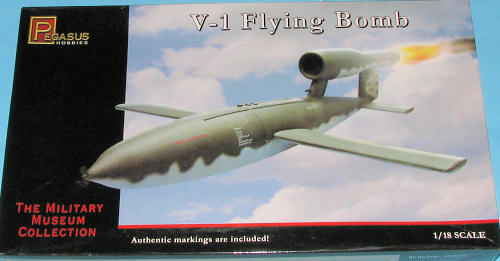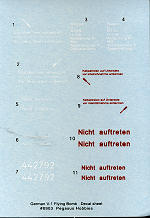
Pegasus Hobbies 1/18 Fi-103A (V-1)
| KIT #: | 8803 |
| PRICE: | $20.25 MSRP |
| DECALS: | One option |
| REVIEWER: | Scott Van Aken |
| NOTES: | Not a complex kit at all. |

| HISTORY |
The Fieseler Fi-103, more commonly called the V-1, was the world's first operational cruise missile. It was a very crude vehicle, but was also most effective in what it was designed to do. It was basically an aerodynamic bomb powered by a pulse jet. The pulse jet is a very simple engine that requires a minimum speed to operate. Once that minimum speed has been reached, fuel is injected into a chamber in spurts (thus the pulse part of the pulse-jet) and then lit, the controlled burning of that fuel provides thrust. It also gives the missile a very distinctive motor-boat sound while in flight.
Guidance is provided by a gyro and a mechanical devise that determines how far the missile goes before the fuel is shut off and the missile falls from the sky. The number of rotations of a small propeller on the nose of the missile is much of what determines how far the missile travels and this can be preset prior to launch.
Several thousand V-1s were launched during late 1944 and into 1945, most of them aimed at Britain or at Dutch ports. After the war, a number of them were captured and tested by the Allies. In the US, Ford reverse engineered the type and it went into service as the JB-2 Loon. The only way to tell the difference between a German and American version is that the US version has a more vertical forward engine pylon that slopes away towards the rear.
| THE KIT |
 Pegasus
Hobbies out of the UK has been producing a growing range of aircraft models,
mostly in 1/48, that are just a step or two away from snap kits. These have few
parts, those that are there are large and as such, make for pretty quick builds
so that we can concentrate on the fun part of these kits; applying paint and
markings.
Pegasus
Hobbies out of the UK has been producing a growing range of aircraft models,
mostly in 1/48, that are just a step or two away from snap kits. These have few
parts, those that are there are large and as such, make for pretty quick builds
so that we can concentrate on the fun part of these kits; applying paint and
markings.
Their V-1 is, to my knowledge, the first of their 1/18 scale kits. The fuselage itself measures out to 16 inches and this is not thin, fragile plastic. The moldings are quite well done with the surfaces having a slightly pebbly finish that seems to be rather common in modern kits. The alignment pins and sockets are huge, meaning no worries on not getting the bits together. Not only that, but they create an excellent fit that matches up the panel lines. This does bring with it the specter of some sunken areas in the part's exterior, but so far, nothing really horrid has shown itself.
With a dozen parts, construction will go quite quickly, making this a real weekend edition. No handling dolly is provided and from the rapidity of construction, it seems to me that this one may well be designed for quality play value, regardless of one's age! Nonetheless, it does appear to be pretty accurate in shape, even down to having blunt trailing edges on the wings, just like on the real thing.
 Instructions
are three well drawn building steps, though with this one, they really are not
needed. A nicely printed decal sheet is included with the usual data markings.
Despite the box top's threat regarding having stickers inside, there were none.
Just a very nicely printed sheet of standard, waterslide decals. According to
the painting and markings guide, this one is to be painted in RLM 71 over RLM
65, though if you look at references, you'll be able to find some that are not
so straight-forward.
Instructions
are three well drawn building steps, though with this one, they really are not
needed. A nicely printed decal sheet is included with the usual data markings.
Despite the box top's threat regarding having stickers inside, there were none.
Just a very nicely printed sheet of standard, waterslide decals. According to
the painting and markings guide, this one is to be painted in RLM 71 over RLM
65, though if you look at references, you'll be able to find some that are not
so straight-forward.
| CONCLUSIONS |
As soon as I saw this, I snapped it up. I mean, how often do you get something of this size for $20 MSRP nowadays? Sure, it is simple, but even in the box it is impressive. Just the sort of thing to get youngsters motivated and thanks to no swastika or other insignia, it is about as PC a model as one can get. If you see this in your LHS, grab it and stand by for a relaxing and stress free build.
| REFERENCES |
http://en.wikipedia.org
November 2008 If you would like your product reviewed fairly and quickly
, please
contact
me or see other details in the
Note to
Contributors.